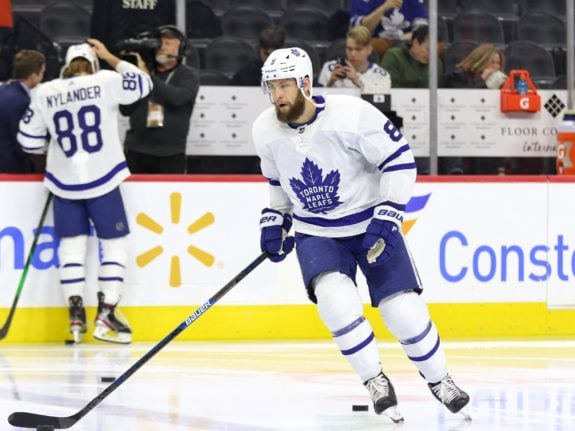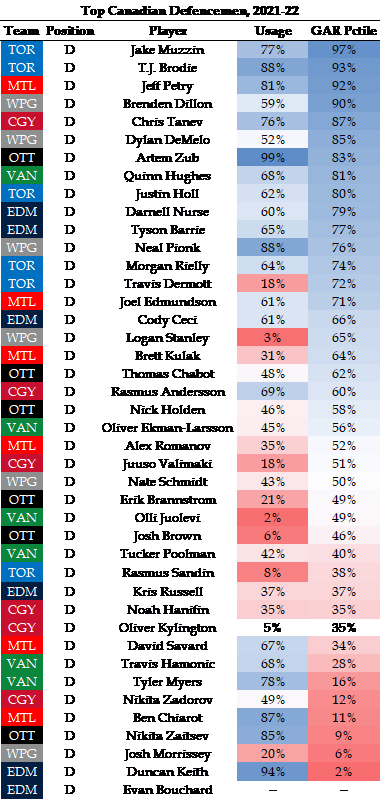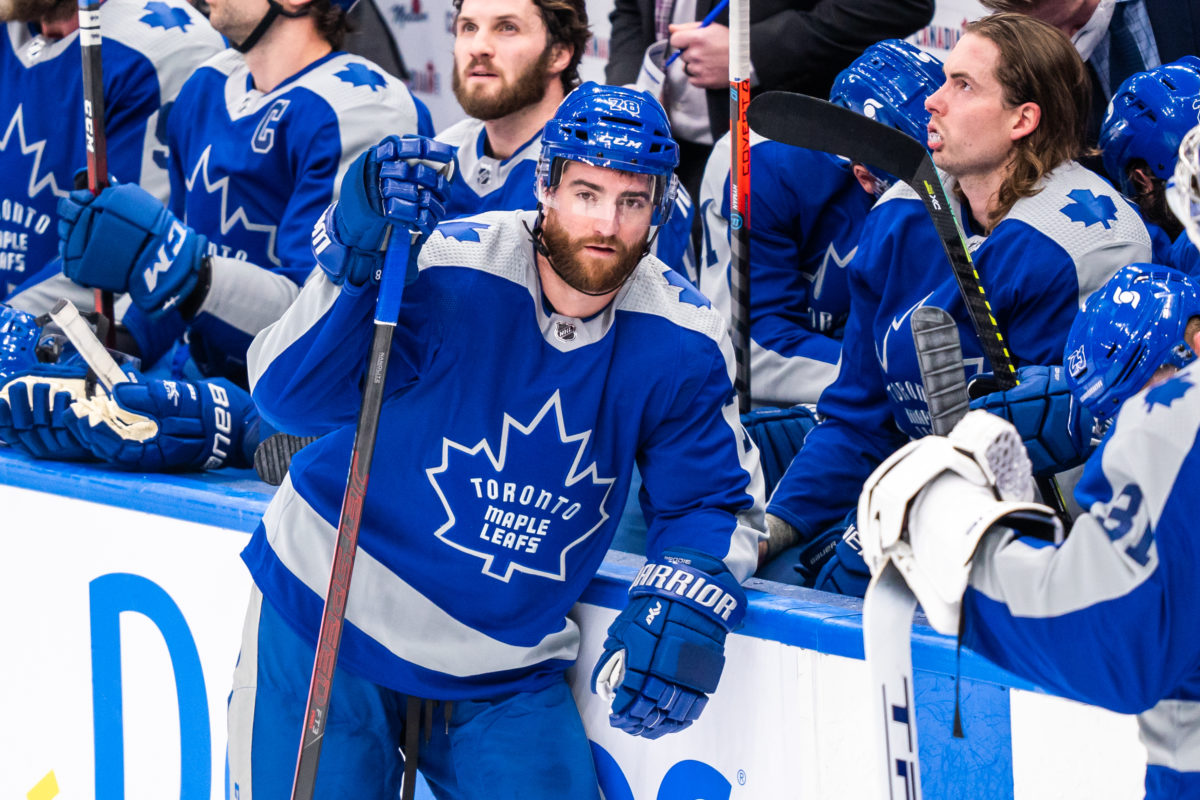Last season the Toronto Maple Leafs made great strides to improve their defensive game. Gone were Tyson Barrie and Cody Ceci. Replacing them were T.J. Brodie, who Maple Leafs general manager had tried to acquire previously in a trade involving Nazem Kadri (Kadri vetoed it because he wanted to stay in Toronto), and Zach Bogosian, who was fresh off of his Stanley Cup win with the Tampa Bay Lightning.
The Moves Worked and the Maple Leafs’ Defense Improved
These defensive changes, and what appeared to be a commitment from Maple Leafs’ forwards to improve their defensive play, helped the team jump from fifth near the bottom of the league in 2019-2020 to sixth from the top in 2020-21 in goals against. During 2019-20, the team gave up 227 goals in 70 games (an average of 3.24 goals-against per game). In 2020-21 that number dropped to 148 goals in 56 games (an average of 2.64 goals-against per game). That drop (almost a whole goal per game) made a huge difference.

Going into the 2021-22 season, the Maple Leafs did not re-sign Bogosian. Instead, they signed a trio of lower-priced defensemen to two-way deals. These defensemen included Alex Biega (who’s played 241 NHL games, but only 13 last season for the Detroit Red Wings), Brennan Menell (whose NHL career totals five games played last season with the Minnesota Wild), and Carl Dahlstrom (who’s played 64 NHL games, but spent last season in the AHL).
Related: Maple Leafs News & Rumors: Robertson, Core Four & Trading Matthews
It seems obvious that none of these players will replace Bogosian. As we approach the Maple Leafs’ training camp, where all this might change, it appears likely that a committee of three players – Travis Dermott, Rasmus Sandin, and Timothy Liljegren – will assume the task of covering Bogosian’s ice time. Biega, Menell, and Dahlstrom will wait in the wings in case one of the three youngsters falters or gets injured.
How Good Will This Maple Leafs’ Defense Be?
Travis Yost of TSN wrote an article recently that ranked the defensemen on all the Canadian teams. To create his ranking, Yost used an advanced statistical analysis called Goals Above Replacement (GAR) to rate the players. In short, although we admit we don’t understand all the deep-level analyses that make up this analytic, GAR formulates the total number of goals a player adds to his team relative to a replacement-level player. It tries to account for and track what players do all over the ice. [The chart is shown below on the right hand side.]

Related: Today in Hockey History: Sept. 13
For our analysis, because GAR has been used regularly since the 2007-08 season, we’ll trust its efficacy and the merit of Yost’s results. Yost’s article ranks players by percentile, which shows each player’s rank among and against other players. For example, a 50 percent player would mean that player is average. Anything above 50 percent is positive, and anything below 50 percent would be considered negative.
Finally, we offer the caveat that any statistical analysis, regardless of its elegance, is only one window to look through when analyzing the value any player brings to his team. There are a ton (used as a metaphor and not an exact weight) of other factors that must be taken into account.
Where Do Maple Leafs’ Defensemen Rank
Given all this conversation, where do the players on the Maple Leafs’ defense rank among defensemen on the Canadian teams according to GAR?
According to Yost’s GAR analysis, the first obvious thing Maple Leafs’ fans will see is that the top two players are Jake Muzzin at 97 percent and T.J. Brodie at 93 percent. The next two players are Jeff Petry of the Montreal Canadiens (92 percent) and Brenden Dillon of the Winnipeg Jets (90 percent).
Related: Ranking NHL Teams By Forwards
Averaging the ranks of the six Maple Leafs’ players on the chart works out to 11.5. Averaging the rating of the six players works out to 75.7 percent. Using GAR as the measuring stick, how do these six players, as a group, rank among the defensemen from other Canadian teams?
If we look at every Maple Leafs’ player on the chart we find the following:
| Rank Among Canadian Defensemen | Player | GAR Percentile |
| 1 | Jake Muzzin | 97 |
| 2 | T.J. Brodie | 93 |
| 9 | Justin Holl | 80 |
| 13 | Morgan Rielly | 74 |
| 14 | Travis Dermott | 72 |
| 30 | Rasmus Sandin | 38 |

When every Canadian team’s defense is ranked, this is what it looks like:
Ranking of Each Team’s Defense
| Canadian Team | Average Rank | Average GAR Percentile |
| Toronto Maple Leafs | 11.5 | 75.7 |
| Winnipeg Jets | 17.3 | 60.8 |
| Montreal Canadiens | 22.5 | 54.2 |
| Ottawa Senators | 23.3 | 51.2 |
| Calgary Flames | 25.2 | 46.7 |
| Vancouver Canucks | 26.2 | 45.8 |
| Edmonton Oilers | 25.2 | 43.5 |
Making Sense of the Rankings of Canadian Teams’ Defenses
So, what can we learn from a comparison of the analytics for Canadian teams’ defensemen? Do the Maple Leafs have the best defense of all the Canadian teams? Perhaps; but, perhaps not. What we do learn is that, using a single metric of GAR, the Maple Leafs’ defense compares favourably to other Canadian teams’ defenses. Different statistics might tell different stories; however, perhaps the improvements the Maple Leafs have made to their defense will continue into this season.
Related: Maple Leafs in a Tough Spot with Defenseman Morgan Rielly
Obviously, were the Maple Leafs once again only competing in the North Division (against all Canadian-based teams), this analysis might be more pertinent. However, as fans know, the Maple Leafs are returning to the Atlantic Division.

In the Atlantic Division, the Maple Leafs will face different teams; however, they will still bring the same solid Maple Leafs’ defense. Perhaps this season’s Maple Leafs’ defense will continue the upward trend that began last season.
[Note: I want to thank long-time Maple Leafs’ fan Stan Smith for collaborating with me on this post. Stan’s Facebook profile can be found here.]